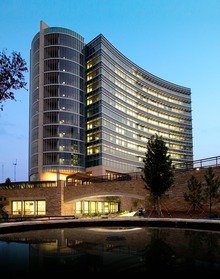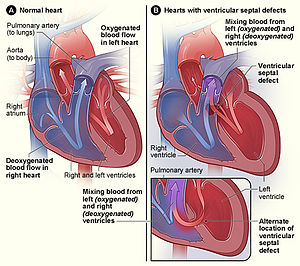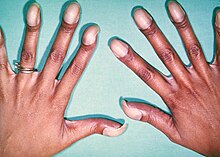 | |
| Agency overview | |
|---|---|
| Formed | July 1, 1946 |
| Preceding agencies |
|
| Jurisdiction | Federal government of the United States |
| Headquarters | Atlanta, Georgia, U.S. |
| Employees | 15,000 |
| Annual budget | US$11.1 billion (FY18) |
| Agency executive |
|
| Parent agency | United States Department of Health and Human Services |
| Website | www |
The Centers for Disease Control and Prevention (CDC) is the leading national public health institute of the United States. The CDC is a United States federal agency under the Department of Health and Human Services and is headquartered in Atlanta, Georgia.
Its main goal is to protect public health and safety through the control and prevention of disease, injury, and disability in the US and internationally. The CDC focuses national attention on developing and applying disease control and prevention. It especially focuses its attention on infectious disease, food borne pathogens, environmental health, occupational safety and health, health promotion, injury prevention and educational activities designed to improve the health of United States citizens. In addition, the CDC researches and provides information on non-infectious diseases such as obesity and diabetes and is a founding member of the International Association of National Public Health Institutes.
History
CDC headquarters in Atlanta, Georgia, as seen from Emory University
CDC's Roybal campus in Atlanta, Georgia
Arlen Specter Headquarters and Emergency Operations Center
Tom Harkin Global Communications Center
The Communicable Disease Center was founded July 1, 1946, as the successor to the World War II Malaria Control in War Areas program of the Office of National Defense Malaria Control Activities.
Preceding its founding, organizations with global influence in malaria control were the Malaria Commission of the League of Nations and the Rockefeller Foundation. The Rockefeller Foundation greatly supported malaria control, sought to have the governments take over some of its efforts, and collaborated with the agency.
The new agency was a branch of the U.S. Public Health Service and Atlanta was chosen as the location because malaria was endemic in the Southern United States. The agency changed names (see infobox on top) before adopting the name Communicable Disease Center in 1946. Offices were located on the sixth floor of the Volunteer Building on Peachtree Street.
With a budget at the time of about $1 million, 59 percent of its personnel were engaged in mosquito abatement and habitat control with the objective of control and eradication of malaria in the United States.
Among its 369 employees, the main jobs at CDC were originally entomology and engineering. In CDC's initial years, more than six and a half million homes were sprayed, mostly with DDT.
In 1946, there were only seven medical officers on duty and an early
organization chart was drawn, somewhat fancifully, in the shape of a
mosquito. Under Joseph Walter Mountin, the CDC continued to advocate for public health issues and pushed to extend its responsibilities to many other communicable diseases.
In 1947, the CDC made a token payment of $10 to Emory University for 15 acres (61,000 m2)
of land on Clifton Road in DeKalb County, still the home of CDC
headquarters today. CDC employees collected the money to make the
purchase. The benefactor behind the “gift” was Robert W. Woodruff, chairman of the board of The Coca-Cola Company. Woodruff had a long-time interest in malaria
control, which had been a problem in areas where he went hunting. The
same year, the PHS transferred its San Francisco based plague laboratory
into the CDC as the Epidemiology Division, and a new Veterinary
Diseases Division was established. An Epidemic Intelligence Service
(EIS) was established in 1951, originally due to biological warfare
concerns arising from the Korean War; it evolved into two-year
postgraduate training program in epidemiology, and a prototype for Field Epidemiology Training Programs (FETP), now found in numerous countries, reflecting CDC's influence in promoting this model internationally.
The mission of CDC expanded beyond its original focus on malaria to include sexually transmitted diseases
when the Venereal Disease Division of the U.S. Public Health Service
(PHS) was transferred to the CDC in 1957. Shortly thereafter,
Tuberculosis Control was transferred (in 1960) to the CDC from PHS, and
then in 1963 the Immunization program was established.
It became the National Communicable Disease Center (NCDC) effective July 1, 1967. The organization was renamed the Center for Disease Control (CDC) on June 24, 1970, and Centers for Disease Control effective October 14, 1980. An act of the United States Congress appended the words "and Prevention" to the name effective October 27, 1992. However, Congress directed that the initialism CDC be retained because of its name recognition.
Currently the CDC focus has broadened to include chronic diseases, disabilities, injury control, workplace hazards, environmental health threats, and terrorism preparedness. CDC combats emerging diseases and other health risks, including birth defects, West Nile virus, obesity, avian, swine, and pandemic flu, E. coli, and bioterrorism, to name a few. The organization would also prove to be an important factor in preventing the abuse of penicillin.
In May 1994 the CDC admitted having sent several biological warfare
agents to the Iraqi government from 1984 through 1989, including Botulinum toxin, West Nile virus, Yersinia pestis and Dengue fever virus.
On April 21, 2005, then–CDC Director Julie Gerberding formally announced the reorganization of CDC to "confront the challenges of 21st-century health threats". The four Coordinating Centers—established under the G. W. Bush Administration and Gerberding—"diminished the influence of national centers under [their] umbrella", and were ordered cut under the Obama Administration in 2009.
Today, the CDC's Biosafety Level 4 laboratories are among the few that exist in the world, and serve as one of only two official repositories of smallpox in the world. The second smallpox store resides at the State Research Center of Virology and Biotechnology VECTOR
in the Russian Federation. The CDC revealed in 2014 that it had
discovered several misplaced smallpox samples and also that lab workers
had potentially been infected with anthrax.
Organization
The
CDC is organized into "Centers, Institutes, and Offices" (CIOs), with
each organizational unit implementing the agency's activities in a
particular area of expertise while also providing intra-agency support
and resource-sharing for cross-cutting issues and specific health
threats. Generally, CDC "Offices" are subdivided into Centers, which in
turn are composed of Divisions and Branches.
However, the Center for Global Health and the National Institute for
Occupational Safety and Health are freestanding organizational units and
do not belong to a parent Office.
The current CIOs are:
- CDC Washington Office
- Center for Global Health
- National Institute for Occupational Safety and Health
- Office for State, Tribal, Local and Territorial Support
- Office of Equal Employment Opportunity
- Office of Infectious Diseases
- National Center for Emerging and Zoonotic Infectious Diseases
- National Center for HIV/AIDS, Viral Hepatitis, STD, and TB Prevention
- National Center for Immunization and Respiratory Diseases
- Office of Minority Health and Health Equity
- Office of Noncommunicable Diseases, Injury and Environmental Health
- National Center for Chronic Disease Prevention and Health Promotion
- National Center for Environmental Health/Agency for Toxic Substances and Disease Registry
- National Center for Injury Prevention and Control
- National Center on Birth Defects and Developmental Disabilities
- Office of Public Health Preparedness and Response
- Office of Public Health Scientific Services
- Center for Surveillance, Epidemiology and Laboratory Services
- National Center for Health Statistics
- Office of the Associate Director for Communication
- Office of the Associate Director for Laboratory Science and Safety
- Office of the Associate Director for Policy
- Office of the Associate Director for Science
- Office of the Chief of Staff
- Office of the Chief Operating Officer
The Office of Public Health Preparedness was created during the 2001
anthrax attacks shortly after the terrorist attacks of September 11,
2001. Its purpose was to coordinate among the government the response to
a range of biological terrorism threats.
Budget and operations
In addition to its Atlanta headquarters, the CDC has other
locations in the United States and Puerto Rico. Those locations include Anchorage; Cleveland; Cincinnati; Detroit; Fort Collins; Hyattsville; Morgantown; Pittsburgh; Research Triangle Park; San Juan, Puerto Rico; Spokane, Washington; and Washington, D.C.
The CDC offers grants
that help many organizations each year advance health, safety and
awareness at the community level throughout the United States. The CDC
awards over 85 percent of its annual budget through these grants.
Workforce
As of 2008, CDC staff numbered approximately 15,000 (including 6,000 contractors and 840 Commissioned Corps
officers) in 170 occupations. Eighty percent held bachelor's degrees or
higher; almost half had advanced degrees (a master's degree or a
doctorate such as a PhD, D.O., or M.D.).
Common CDC job titles include engineer, entomologist, epidemiologist, biologist, physician, veterinarian, behavioral scientist, nurse, medical technologist, economist, public health advisor, health communicator, toxicologist, chemist, computer scientist, and statistician.
The CDC also operates a number of notable training and fellowship programs, including those indicated below.
Epidemic Intelligence Service (EIS)
The Epidemic Intelligence Service (EIS) is composed of "boots-on-the-ground disease detectives" who investigate public health problems domestically and globally.
When called upon by a governmental body, EIS officers may embark on
short-term epidemiological assistance assignments, or "Epi-Aids", to
provide technical expertise in containing and investigating disease
outbreaks. The EIS program is a model for the international Field Epidemiology Training Program.
Public Health Associates Program
The
CDC also operates the Public Health Associate Program (PHAP), a
two-year paid fellowship for recent college graduates to work in public
health agencies all over the United States. PHAP was founded in 2007 and
currently has 159 associates in 34 states.
Leadership
David Sencer points to a depiction of Triatomine sp., which transmits Chagas disease.
The Director of CDC is a Senior Executive Service position that may be filled either by a career employee, or as a political appointment that does not require Senate confirmation,
with the latter method typically being used. The director serves at the
pleasure of the President and may be fired at any time. The CDC director concurrently serves as the Administrator of the Agency for Toxic Substances and Disease Registry.
Sixteen directors have served the CDC or its predecessor agencies.
- Louis L. Williams Jr., MD (1942–1943)
- Mark D. Hollis, ScD (1944–1946)
- Raymond A. Vonderlehr, MD (1947–1951)
- Justin M. Andrews, ScD (1952–1953)
- Theodore J. Bauer, MD (1953–1956)
- Robert J. Anderson, MD, MPH (1956–1960)
- Clarence A. Smith, MD, MPH (1960–1962)
- James L. Goddard, MD, MPH (1962–1966)
- David J. Sencer, MD, MPH (1966–1977)
- William H. Foege, MD, MPH (1977–1983)
- James O. Mason, MD, MPH, Ph.D (1983–1989)
- William L. Roper, MD, MPH (1990–1993)
- David Satcher, MD, PhD (1993–1998)
- Jeffrey P. Koplan, MD, MPH (1998–2002)
- Julie Gerberding, MD, MPH (2002–2008)
- Thomas R. Frieden, MD, MPH (2009–Jan 2017)
- Anne Schuchat, MD, RADM USPHS (Jan–July 2017, acting)
- Brenda Fitzgerald, MD (July 2017–Jan 2018)
- Anne Schuchat, MD (Jan–Mar 2018, acting)
- Robert R. Redfield, MD (March 2018–)
Datasets and survey systems
- CDC Scientific Data, Surveillance, Health Statistics, and Laboratory Information.
- Behavioral Risk Factor Surveillance System (BRFSS), the world’s largest, ongoing telephone health-survey system.
- Mortality Medical Data System.
- Abortion statistics in the United States
Areas of focus
Donald Henderson as part of the CDC's smallpox eradication team in 1966.
Communicable diseases
The
CDC's programs address more than 400 diseases, health threats, and
conditions that are major causes of death, disease, and disability. The
CDC's website has information on various infectious (and noninfectious)
diseases, including smallpox, measles, and others.
Influenza
The CDC has launched campaigns targeting the transmission of influenza, including the H1N1 swine flu, and launched websites to educate people in proper hygiene.
Division of Select Agents and Toxins
Within
the division are two programs: the Federal Select Agent Program (FSAP)
and the Import Permit Program. The FSAP is run jointly with an office
within the U.S. Department of Agriculture, regulating agents that can
cause disease in humans, animals, and plants. The Import Permit Program
regulates the importation of "infectious biological materials."
The CDC runs a program that protects the public from rare and dangerous substances such as anthrax and the Ebola virus. The program, called the Federal Select Agent Program, calls for inspections of labs in the U.S. that work with dangerous pathogens.
During the 2014 Ebola outbreak in West Africa, the CDC helped coordinate the return of two infected American aid workers for treatment at Emory University Hospital, the home of a special unit to handle highly infectious diseases.
As a response to the 2014 Ebola outbreak, Congress passed a
Continuing Appropriations Resolution allocating $30,000,000 towards
CDC's efforts to fight the virus.
Non-communicable diseases
The CDC also works on non-communicable diseases, including chronic diseases caused by obesity, physical inactivity and tobacco-use.
Antibiotic resistance
The CDC implemented their National Action Plan for Combating Antibiotic Resistant Bacteria
as a measure against the spread of antibiotic resistance in the United
States. This initiative has a budget of $161 million and includes the
development of the Antibiotic Resistance Lab Network.
Global health
The
CDC works with other organizations around the world to address global
health challenges and contain disease threats at their source. It works
closely with many international organizations such as the World Health Organization
(WHO) as well as ministries of health and other groups on the front
lines of outbreaks. The agency maintains staff in more than 60
countries, including some from the U.S. but even more from the
countries in which it operates.
The agency's global divisions include the Division of Global HIV and TB
(DGHT), the Division of Parasitic Diseases and Malaria (DPDM), the
Division of Global Health Protection (DGHP), and the Global Immunization
Division (GID).
The CDC is integral in working with the WHO to implement the International Health Regulations (IHR),
a legally binding agreement between 196 countries to prevent, control,
and report on the international spread of disease, through initiatives
including the Global Disease Detection Program (GDD).
The CDC is also a lead implementer of key U.S. global health initiatives such as the President's Emergency Plan for AIDS Relief (PEPFAR) and the President's Malaria Initiative.
Travelers' health
The CDC collects and publishes health information for travelers in a comprehensive book, CDC Health Information for International Travel, which is commonly known as the "yellow book."
The book is available online and in print as a new edition every other
year and includes current travel health guidelines, vaccine
recommendations, and information on specific travel destinations. The CDC also issues travel health notices on its website, consisting of three levels:
"Watch": Level 1 (practice usual precautions)
"Alert": Level 2 (practice enhanced precautions)
"Warning": Level 3 (avoid nonessential travel)
Foundation
The CDC Foundation operates independently from CDC as a private, nonprofit 501(c)(3) organization incorporated in the State of Georgia. The creation of the Foundation was authorized by section 399F of the Public Health Service Act
to support the mission of CDC in partnership with the private sector,
including organizations, foundations, businesses, educational groups,
and individuals.
Popular culture and controversies
Historically, the CDC has been relatively free of political manipulation.
Tuskegee Study of Untreated Syphilis in the Negro Male
For 15 years, the CDC had direct oversight over the Tuskegee syphilis experiment.
In the study, which lasted from 1932 to 1972, a group of African
American men (nearly 400 of whom had syphilis) were studied to learn
more about the disease. Notably, the disease was left untreated in the
research subjects and they never gave their informed consent to serve as
research subjects. The Tuskegee Study was initiated in 1932 by the Public Health Service. The CDC took over the study in 1957.
The CDC's response to the AIDS crisis in the 1980s has been
criticized for promoting some public health policies that harmed HIV+
people and for providing ineffective public education. The agency's
response to the 2001 anthrax attacks was also criticized for ineffective communication with other public health agencies and with the public.
CDC zombie apocalypse outreach campaign
On May 16, 2011, the Centers for Disease Control and Prevention's blog published an article instructing the public on what to do to prepare for a zombie
invasion. While the article did not claim that such a scenario was
possible, it did use the popular culture appeal as a means of urging
citizens to prepare for all potential hazards, such as earthquakes,
tornadoes, and floods.
According to David Daigle, the Associate Director for
Communications, Public Health Preparedness and Response, the idea arose
when his team was discussing their upcoming hurricane-information
campaign and Daigle mused that "we say pretty much the same things every
year, in the same way, and I just wonder how many people are paying
attention." A social-media employee mentioned that the subject of
zombies had come up a lot on Twitter when she had been tweeting about the Fukushima Daiichi nuclear disaster and radiation.
The team realized that a campaign like this would most likely reach a
different audience from the one that normally pays attention to
hurricane-preparedness warnings and went to work on the zombie campaign,
launching it right before hurricane season began. "The whole idea was,
if you're prepared for a zombie apocalypse, you're prepared for pretty
much anything," said Daigle.
Once the blog article became popular, the CDC announced an open contest for YouTube submissions of the most creative and effective videos covering preparedness for a zombie apocalypse (or apocalypse of any kind), to be judged by the "CDC Zombie Task Force". Submissions were open until October 11, 2011. They also released a zombie-themed graphic novella available on their website. Zombie-themed educational materials for teachers are available on the site.
Gun violence
One area of current partisan dispute related to CDC funding is studying gun violence. The 1996 Dickey Amendment
states "none of the funds made available for injury prevention and
control at the Centers for Disease Control and Prevention may be used to
advocate or promote gun control". Advocates for gun control oppose the amendment and have tried to overturn it.
In 1992, Mark L. Rosenberg
and five CDC colleagues founded the CDC’s National Center for Injury
Prevention and Control, with an annual budget of c. $260,000 that
focused on "identifying the root causes of firearm deaths and the best
methods to prevent them". Their first report which was published in the New England Journal of Medicine
in 1993, entitled "Gun Ownership as a Risk Factor for Homicide in the
Home" reported that the "mere presence of a gun in a home increased the
risk of a firearm-related death by 2.7 percent, and suicide fivefold—a
"huge" increase." In response, the NRA launched a "campaign to shut down the Injury Center." Doctors for Responsible Gun Ownership and Doctors for Integrity and Policy Research joined the pro-gun effort and by 1995, politicians also supported the pro-gun initiative. In 1996, Jay Dickey (R) Arkansas introduced the Dickey Amendment
statement "which stated "none of the funds made available for injury
prevention and control at the Centers for Disease Control and Prevention
may be used to advocate or promote gun control" as a rider in the 1996 appropriations bill."
In 1997, "Congress redirected all of the money previously earmarked for
gun violence research to the study of traumatic brain injury." David Satcher, who was the CDC head from 1993 to 1998 advocated for gun violence research until he left in 1998. In 1999 Rosenberg was fired. Over a dozen "public health insiders, including current and former CDC senior leaders" told The Trace
interviewers that CDC senior leaders took an overly cautious stance in
their interpretation of the Dickey amendment. They could have done much
more. Rosenberg told The Trace in 2016, "Right now, there is nothing stopping them from addressing this life-and-death national problem.”
The American Medical Association, the American Psychological Association and the American Academy of Pediatrics
sent a letter to the leaders of the Senate Appropriations Committee in
2013 asking them "to support at least $10 million within the Centers for
Disease Control and Prevention (CDC) in FY 2014 along with sufficient
new funding at the National Institutes of Health to support research
into the causes and prevention of gun violence. Furthermore, we urge
Members to oppose any efforts to reduce, eliminate, or condition CDC
funding related to gun violence prevention research." Congress maintained the ban in subsequent budgets.
Language guidelines
In December 2017, The Washington Post reported that the Trump administration had issued a list of seven words that were forbidden in official CDC documentation. Yuval Levin, after contacting HHS officials, wrote in National Review that the Post story was not accurate.
Publications
- CDC publications
- State of CDC report
- CDC Programs in Brief
- Morbidity and Mortality Weekly Report
- Emerging Infectious Diseases (monthly journal)
- Preventing Chronic Disease
- Vital statistics










